Artistic Director Spektrum
This year, the Minett Mash-Up travelling podcast is back on a journey of discovery through the Minett UNESCO Biosphere. Until the end of the year, we will stop in all 11 municipalities of the biosphere reserve and talk to our guests about the Minett region, their work and projects, the unique nature of Luxembourg’s south and the industrial heritage of the (former) steel and mining region.
For the kick-off of our podcast this year, we stop in Luxembourg’s southernmost city, Rumelange, and have the artistic director of the Spektrum project, Teena Lange, as our guest.
Our guest: Teena Lange
Teena Lange has only been in Luxembourg since last year. The German performance artist, who studied theatre and performance in Leipzig, Paris and Berlin, lived in Berlin until recently, where she still regularly returns. Over the past decade she has been involved in “Grüntaler 9”, a venue dedicated to the promotion of performance art.
In addition to her work as a curator in Berlin, Teena has also worked as an artist or curator in Istanbul, New York, London, Jerusalem and Brussels, to name but a few. Since last spring, Teena, together with Sebastian Häger, has been running Spektrum in Rumelange.
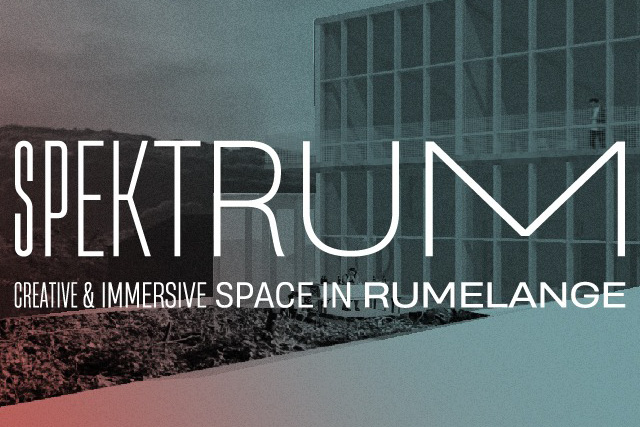 |
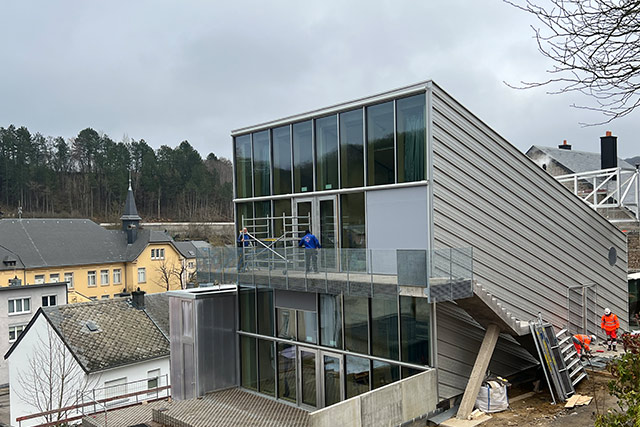 |
 |
 |
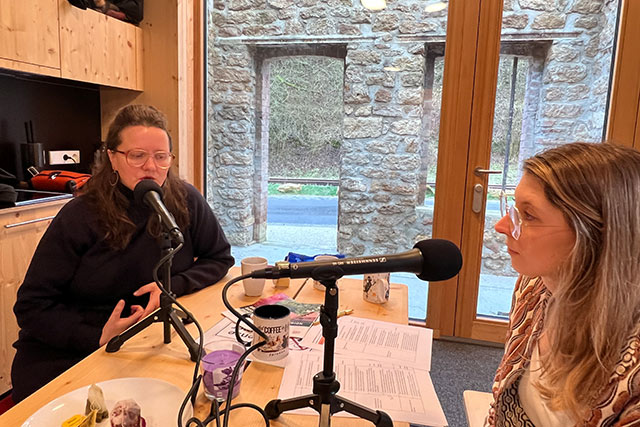 |
 |
Spektrum, located in the house of the well-known Rumelange sculptor Albert Hames, is a meeting place that emerged as an Esch2022 project with a focus on process-based, experimental and immersive cultural and artistic practices as well as creative tourism. ln its immersive, structural and programmatic architecture, interdisciplinary perspectives on the future, present and past as well as people, art and cultural heritage are to be connected.
SPEKTRUM is intended to be a forum for questions of the present, such as interculturality, ecology, sustainability, always in connection with concrete questions from the local social space. The immersive technologies on site offer the possibility to develop and try out new forms and formats of (inter)cultural and artistic practices. Through the interactive approach of the house and the possibilities of intervention with the legacy of Albert Hames, the question of ownership and handling of cultural assets is posed anew. This approach is to be further developed and accompanied in the project, and together a contemporary culture of knowledge is to be exchanged and lived.
Links:
| Teena Lange | ||
| Spektrum |
Our Minett location of the month: Rumelange
The city of Rumelange
At the upper end of the Kayl valley, on the French border, lies the small city of Rumelange. Between 1863 and 1978, Rumelange had mines and iron ore was extracted from the ground. To this day, the Musée National des Mines de Fer bears witness to the industrial past of the small city, which was granted city rights in 1907.
Kabaischen of the month: Gonner House
In 2023, each episode of our podcast will come from a Kabaischen of the Minett Trail. This premium hiking trail, which connects the 11 municipalities of the Minett UNESCO Biosphere with each other over a length of 90 kilometres, is the common thread of this season.
For our episode in Rumelange, we receive our guest at the Gonner Haus.
The Gonner Haus, built in 1900, is made of three different materials, all from the region: limestone from Rumelange, as it is still quarried today in the Cimalux open-cast mine on the border with the neighbouring French municipality of Ottange, Minett stones and bricks that were manufactured in Bettembourg.
The Minett Trail hostel is named after Nicolas Gonner-Nau, a former mayor of the municipality of Kayl, to which Rumelange belonged until 1891, and founder of the Rumelange steelworks, which was in operation from 1872 to 1921. A restart of the plant in 1929 failed due to the world economic crisis. After 1941, most of the steelworks in Rumelange has been demolished.
 |
 |
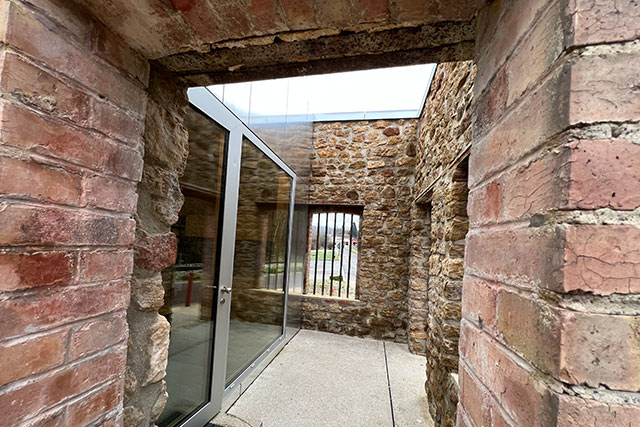 |
 |
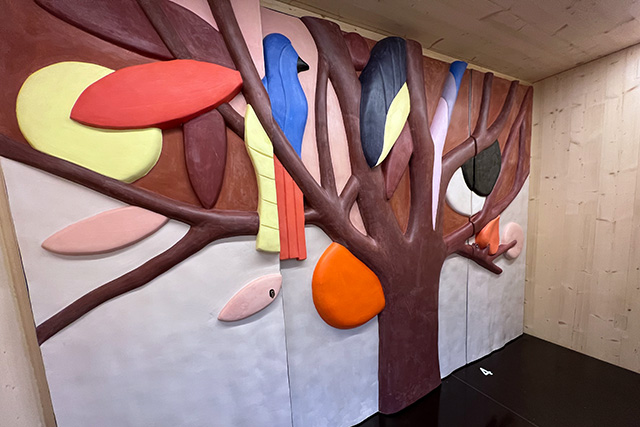 |
 |
The renovated Gonner Haus can accommodate 8 hikers and has been preserved in its original appearance. A “box-in-a-box” system has turned the workers’ cottage into a comfortable place to spend the night. Local artists have painted the doors with frescoes in natural colours. The artists also incorporated handmade clay birdhouses for migratory birds in the cavities of the outer wall. The swift likes to nest in old buildings, like the Gonner Haus.
Since last summer, the Gonner Haus, which is literally a stone’s throw from the National Mining Museum, can be booked for 210€ per night.
Our quiz
The owner of the Gonner Haus, Nicolas Gonner, was also the owner of the mine here in Rumelange, but what else was he?
A: Horse breeder
B: Mayor of Kayl
C: politician in parliament
Nicolas Gonner was born in Rumelange on 17 October 1824. It is assumed that his family was already trading in floor ore before the mining industry actually began in the Minett and thus achieved considerable prosperity. After his father’s death, Nicolas Gonner took over the family farm in Rumelange in 1852, but soon also began to buy several parcels of land in the Kayl Valley in order to later mine iron ore in these areas. In 1872 Gonner founded the steelworks in Rumelange together with other business partners.
Gonner was also politically active and between 1855 and 1884, with interruptions, he was mayor of the municipality of Kayl, to which Rumelange still belonged at that time. Nicolas Gonner died in Rumelange in 1908, aged 83.
We are not far from the national mining museum here in Rumelange. Visitors can take a train directly into the gallery, how deep is it?
A: 200m
B: 70m
C: 1000m
As Luxembourg lies at the northern end of the Lorraine iron ore basin, it is relatively easy to reach the valuable mineral. While it was increasingly mined above ground in open-cast mines after the Second World War, iron ore was mostly extracted underground in the second half of the 19th century and the first half of the 20th century.
The Walert mine, which became the national mining museum after its closure, is therefore on average only 70m below the surface. The mine is regularly open to visitors and shows inside not only the work of the miners but also the technical development that mining underwent in Luxembourg between the 1870s and the 1980s.
Rumelange has something very special to offer near the Arboretum “An Aenzelen” not far from the city park. What exactly?
A: The longest quarry edge of an open-cast mine in Luxembourg.
B: The only mine in Luxembourg where gold was extracted
C: The only limestone tufa spring in the Minett UNESCO Biosphere
The arboretum “An Aenzelen”, which was established in 1993 in the immediate vicinity of the city park of Rumelange, is bordered on one side by the quarry edge of an old open-cast iron ore mine. This was cleared of bushes by the nature administration last autumn in order to preserve an important habitat for insects and lizards. A limestone tufa spring also springs from this quarry edge. It is the only one of its kind on the territory of the Minett UNESCO Biosphere, but it is far less known than comparable lime tufa springs in the Mullerthal region.
Links to the topics of this episode:
- Grüntaler 9 – cultural site for performance art in Berlin
- Albert Hames – Sculptor from Rumelange
- Albert Hames House – Listed house of the Hames family, where Albert Hames lived and had his studio until his death
- Spektrum – Immersive cultural-touristic centre of the city of Rumelange in the Hames House
- 2001 & Njoy – Architects’ offices who planned the Spektrum
- Rumelange – smallest municipality in terms of area in the Minett UNESCO Biosphere
- Minett Trail – premium hiking trail through the 11 municipalities of the Minett UNESCO Biosphere
- Kabaisercher – hostels along the Minett Trail, some of which were created by renovating old, industrial buildings
- Gonnerhaus – Kabaischen of the town of Rumelange on the Minett Trail
- Jean-Pierre Bausch – former deputy mayor of Rumelange, first miner to sit in the Parliament
- Haard nature reserve – core zone of the Minett UNESCO Biosphere
- Léiffrächen nature reserve – Minett UNESCO Biosphere core zone
- Musée National des Mines de Fer Rumelange – national mining museum – one of the largest museums of its kind in Europe
- Arboretum „An Aenzelen“ – arboretum in Rumelange, which is part of the city park
- Musée Ferrum – new local museum about the iron and steel past and the work of the miners in Tétange
- Tufière – geological explanations about these sources (in french only)
- Minute/Year – art project installed from 01/01 to 31/12/2023 at the Spektrum
- Multiplica – digital arts festival at Rotondes in Bonnevoie
- Jorge Crowe – argentine artist present at Multiplica and first artist in residence at Spektrum
This podcast is realised with the support of:
 |
 |
 |
Contact us:
 |
 |
 |



